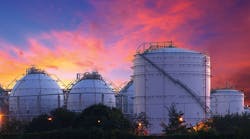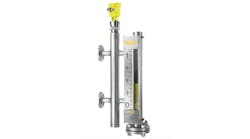The purpose of tank gauging is to measure the contents of tanks and vessels for inventory control and custody transfer. Most process plants have tanks that hold feedstock or finished products, and some may have dozens of large tanks, often 50 feet or more in height and diameter, holding millions of dollars’ worth of feedstock or product. Monitoring and controlling the volumes of tank contents is important to ensure accurate data for financial statements, as well as production planning and scheduling. Inaccurate measurements may result in suboptimal productivity, accounting errors and environmental incidents through spills.
Monitoring tank inventory levels traditionally involved two operators, one in the field and one in the control room. The field operator takes the reading from a tank level gauge, and tells the control room operator to start/stop the pumps. The practice is expensive, resulting in hundreds of thousands of dollars in costs every year. In addition, it exposes field operators to hazards, including falls and hazardous vapors.
To improve safety, efficiency and accuracy, many plants choose to automate tank gauging, and integrate tank level information with control and business systems. Any such effort must first gather the following information:
- Who needs tank inventory information, how frequently, and in what formats;
- Relevant regulations and standards;
- Required level of accuracy;
- Additional functions, e.g. pump control, overfill protection.
- Software and integration requirements;
- Available or practical networks, e.g. wired, wireless, cellular, fiber-optic;
- Properties of the measured fluids; and
- Configurations, environments and properties of the tanks or vessels.
Hydrostatic principles
Feedstocks received, internal transfers and delivered products are often measured in incompatible volumetric or mass-based units. Conversions from volume to mass and vice versa are frequent, requiring accurate measurements of water interface, density and temperature, as well as product level.
Either mass or volume measurement techniques can be used. Mass or volume can be derived from level; mass can be inferred by means of pressure transmitters. Additional information can be obtained by measuring vapor temperature and pressure. Density measurement can also be added, with accuracies from 0.5% up to 0.1%. Whichever technique is selected, it should be compatible with the operations of all parties using the data from the system.
Hydrostatic tank gauging (HTG) is the traditional pressure-based method of measuring tank contents. A simple HTG system uses a single transmitter near the tank bottom. The total mass of material above the transmitter can be calculated by multiplying the measured pressure by the equivalent area of the tank.
By adding a second transmitter at a known distance (usually 1.5-2.5 m) above the first, the observed density of the material can be calculated from the pressure differential. The level can be calculated from the density and the lower pressure measurement.
A third transmitter can be added to the vapor space above the liquid to compensate for the effects of vapor pressure. This approach is generally not suitable for pressurized tanks where the tank pressure is large compared to the hydrostatic pressures used to measure tank level.
Using highly accurate, digital smart transmitters, HTG systems can measure mass to within 0.5% or better. However, as level instruments, HTG accuracy is typically 40-60 mm, which may not be good enough for custody transfer or inventory value assessment.
HTG systems also measure density over a limited range near the bottom of the tank. If the liquid level is below the upper transmitter, there's no differential pressure measurement. And in some applications, the fluid density near the bottom of the tank is different from the density at higher levels. This density stratification has a significant effect on the calculated values for level and volume.
Level-based systems
An alternative to HTG, level-based systems use a level gauge and combine its reading with separate temperature and density measurements. Temperature is measured using a spot or average temperature sensor. An accurate average temperature measurement is essential to achieve accurate inventory calculations, especially when liquid temperature is stratified.
Density at reference temperature may be determined by laboratory analysis of a grab sample, or by using reference tables for well-characterized materials.
The gross observed volume (GOV) is derived from the level reading and a tank capacity (strapping) table. The gross standard volume (GSV) is calculated by correcting the GOV with a volume-correction factor calculated from the temperature, density at reference temperature, and ASTM or API tables. The total mass is then calculated from the GSV multiplied by the density at reference temperature.
Correction may be required for sediment and water, using interface measurements provided by specialized level instrumentation. Modern, level-based tank-gauge systems may include interface detection, temperature instrumentation, overfill sensors, and the ability to program strapping and density parameters to provide a complete measurement.
Tank gauging focuses on static quantity measurements of liquids in bulk storage. Measurements may be either level- or pressure-based, and usually must be converted to standard mass or volume units by correcting for temperature and/or pressure.
Accuracy requirements drive much of the lifecycle cost of a tank-gauging system. Requirements for custody transfer, inventory reconciliation and leak detection may be an order of magnitude tighter than for operations inventories, where repeatability and reliability may be more important than accuracy.
In applications involving custody transfer or assessment of taxes, duties or royalties, the gauging instruments and inventory control system must be officially approved and certified for this purpose.
Along with repeatability, a reliable tank-gauging system helps prevent overfills and spills, and avoids shutdowns due to feedstock shortages. A high degree of accuracy and reliability will allow operations to safely use the maximum tank capacity, which can materially increase storage capacity. Reliability also reduces maintenance, repair and calibration costs.
Different sensor technologies operate in different ways, which directly affects how they're installed. Level-based tank gauging systems may use a physical float or floats (for detecting an interface between two immiscible liquids), whose position along a vertical probe is detected using a magnetostrictive pulse.
Alternately, a radar wave may be sent along a vertical wave guide; the dielectric discontinuity at the surface creates a reflection that can be used to calculate the level. Radar can also be used in an “open beam” fashion to detect the surface of the liquid.
A third distinct approach is mechanical servo and float-and-tape gauges that involve lowering a float or displacer into the tank. The change in apparent weight of the float or displacer at the surface (or interface) indicates the level of interest.
All require stable mounting for accuracy. Most will require some degree of tank modification, and those costs can be significantly larger than the cost of the level transmitter. The installed costs of an automatic tank gauging system include its instrumentation costs as well as the costs of tank modifications, cabling and conduit, and auxiliary equipment.
Beyond the tank
Additional installation considerations include safety, communications and auxiliary equipment, such as heaters, displays, field modules and software.
Many tank gauging applications involve flammable products, hazardous areas and exposure to lightning. Instruments may have to be explosion-proof, and sensor circuits intrinsically safe. Their position on top of storage tanks makes this equipment more vulnerable to lightning damage, requiring well designed, field-proven, lightning-protection methods. Proper grounding and shielding will also help protect against damage by lightning.
Cable, conduit and communications choices aren't the same for all level technologies, even when transmitters are specified with the same output protocol. There may be significant differences in pricing and availability.
Auxiliary equipment may include heaters for cold-weather applications, protocol converters for proprietary protocols, specialty tools for service or installation, and licensed software. A simple site survey and official quote from the gauge manufacturer (with line-item details) are the best ways to determine added costs and avoid surprises.
Software ranges from basic gauge management packages to inventory management systems integrated with the enterprise. An inventory management system can collect measurement data from multiple tank gauges, monitor alarms and functional parameters, and compute inventory volume and mass in real time. Volumes and masses should be calculated the same way as authorities and surveyors. The software should store tank table parameters, calculate observed and standard volumes, correct for free water, and if applicable, correct for floating roof immersion.
The system may control inlet and outlet valves, start and stop pumps, display data from other transmitters, provide shipping documents, provide trend curves, show bar graph displays, perform leak detection, calculate flow rates, control alarm annunciation relays, perform diagnostic tasks and more.
Lifecycle costs
Virtually any level measurement technology can be used in almost any tank and be made to meet the requirements. The difference is the lifecycle cost, which includes of installation, maintenance and calibration costs. Understanding all the installation considerations before starting will keep a project from exceeding budgets and minimize headaches. Before any work is done, answer the following questions:
- What is the stilling well type and how will it impact level transmitter choice?
- What are the process connection type and size, and how will they affect including access for maintenance?
- How much modification will be required to the tank, and what will it cost?
- What is the total cost of cabling, conduit and/or wireless associated with the project?
- What auxiliary equipment (such as heaters, displays and field modules) will be needed, and what will it cost?
Studying these areas of installation consideration will help determine which technology best suits an existing tank. Talk to tank gauge manufacturers to determine installation requirements on each tank, and make an informed decision on the installed costs of the system, not just the instrument specifications.





